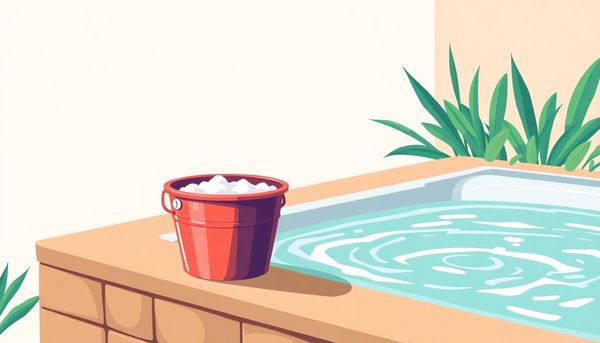Transform Your Backyard with a Saltwater Hot Tub: Benefits & Tips
August 12th, 2024
August 12th, 2024
Glimmering under a starlit sky, your saltwater hot tub stands as a testament to relaxation and luxury, a personal oasis nestled comfortably in your backyard. As you dip your toes into the warm, soothing embrace of the saline water, the cares of the day begin to dissolve, much like the salt in your bubbling sanctuary. The allure of a saltwater hot tub is undeniable, offering a plethora of benefits over its traditional chlorinated counterpart. However, the true essence of owning such a distinctive feature extends beyond mere indulgence.
During a recent visit to a friend’s home, I experienced firsthand the subtle difference that a saltwater system brings. Unlike the sharp chemical scent often associated with chlorinated tubs, the air was refreshingly clean, a gentle reminder of the ocean's vast embrace. The water felt silkier, and my skin, usually sensitive, emerged free from irritation. It's these subtle pleasures that often tip the scales for those contemplating the switch.
Owning a saltwater hot tub, however, is not without its challenges. Maintenance requires understanding the delicate balance of salt levels, and initial installation can pinch the wallet a bit more than expected. Yet, for those who seek a tranquil retreat that whispers of the sea, the investment may well be worth it. In exploring the truth about these aquatic havens, we dive into the heart of what it means to own a slice of waterborne bliss.

Saltwater hot tubs have gained popularity, not just for their ability to reduce chemical usage, but also for the myriad benefits they offer to the body and mind. Transitioning to a salt water system can seem daunting, yet the rewards are worth the leap. One friend of mine, who switched his hot tub to salt water, often raves about how much softer his skin feels after a soak. Unlike the harshness of typical chlorine, salt water provides a gentler, more soothing experience that leaves users feeling refreshed rather than dried out.
For those who enjoy long soaks, the reduced chlorine smell is a huge plus. Salt water systems generate just the right amount of chlorine needed for sanitization, keeping unpleasant odors and chloramines at bay. This fine-tuned balance not only protects your senses but also your health, as it minimizes irritation to your eyes and respiratory system.
Beyond the sensory benefits, there's also the joy of simplified maintenance. With salt systems monitoring chlorine levels, homeowners spend less time fussing with chemical adjustments and more time enjoying their hot tub. It’s a feature that appeals to anyone who prefers relaxation over routine. Plus, salt itself is more cost-effective and easier to handle than traditional chlorine or bromine tablets, meaning your wallet can take a break too. All in all, the switch to a salt water hot tub brings serenity, savings, and an enhanced soaking experience.
Swapping out the traditional chemical routine for a salt water system is like trading in a loud, clunky engine for a smooth, quiet one. The process of converting your hot tub to a salt water oasis is less daunting than you might think. First, it's essential to choose between a drop-in or in-line chlorinator. A drop-in chlorinator is perfect for those who prefer a no-fuss installation, requiring only a few simple steps to get started. On the other hand, an in-line system requires a more permanent setup, connecting directly to your hot tub’s plumbing. If plumbing isn’t your forte, hiring a professional could be wise.
Once you've settled on the type, the preparation begins. Thoroughly clean your tub to remove any lingering chemicals. A spa line flush is your best friend here, clearing out biofilms and unwanted residues. Use a hose filter when refilling to ensure the water starts as clean as possible, minimizing future maintenance.
Adding salt is straightforward—about 2 1/3 cups per 100 gallons of water. This keeps salinity levels within the sweet spot of 2,000 to 3,000 ppm. After adjusting pH and alkalinity, introduce the chlorinator to the water, following manufacturer instructions to set it up efficiently. While you might expect a tang of salt, the level is so low it remains imperceptible, leaving you free to enjoy the skin-friendly soak. Transitioning to a salt water tub offers a gentler experience, reducing harsh chemical exposure without losing the sanitizing benefits.
When contemplating the transition to a salt water hot tub, ensuring a safe installation is paramount. A friend once shared how their excitement quickly turned to frustration due to a poor setup, which serves as a cautionary tale. First and foremost, gauge whether your current hot tub can accommodate a salt water system without voiding its warranty. This small yet crucial step safeguards against unforeseen complications.
For those inclined towards DIY projects, the drop-in chlorinator is a favorable choice. It requires minimal alterations—simply submerge the chlorinator cell and plug in the controller above ground. However, it's essential to secure the cord properly to avoid tripping hazards around the tub’s perimeter. In contrast, if you opt for an in-line system, seeking professional assistance is advisable. It involves altering the plumbing, and incorrect installation can lead to costly repairs.
Next, the importance of a hose filter cannot be overstated. It helps prevent metals and minerals from entering your spa, maintaining your water’s purity from the get-go. Once your hot tub is filled, a thorough water test ensures that salinity, pH, and alkalinity levels are within the recommended range. This initial testing phase is critical. It sets the stage for a balanced and enjoyable hot tub experience, minimizing the need for frequent adjustments.
Lastly, patience pays off when introducing salt. Add it gradually, allowing the chlorinator to monitor and stabilize the water’s chemistry effectively. This careful approach not only protects your investment but also ensures many serene, stress-free soaks in your salt water sanctuary.
Mastering the art of water care in a salt water hot tub can transform your experience from ordinary to extraordinary. It starts with understanding the relationship between salt and chlorine. Unlike traditional systems, a salt water hot tub harnesses electrolysis to convert salt into chlorine, providing a gentler soak by avoiding the harshness of traditional chemical additives. This process relies heavily on maintaining the correct salinity levels—around 2,000 to 3,000 ppm. It's a delicate balance that keeps the water soft and your skin happy.
Imagine the relief of fewer chemical purchases and simpler maintenance. By routinely checking salinity along with pH and alkalinity, you'll ensure your system operates smoothly. Monthly salinity checks become your new ritual, using either digital readers or specially designed test strips. This step is crucial as it assures the chlorinator is accurately reading your water levels, preventing unnecessary overproduction of chlorine.
But here's where the real optimization lies: regular cleaning of the chlorinator cell, which should be soaked in a mild acid solution as per the manufacturer's advice. This keeps the system efficient, extending the life of the components. Additionally, protecting metal parts from corrosion by wiping them down frequently safeguards your investment. In the end, a little diligence goes a long way in creating a serene and sustainable hot tub sanctuary.

Transforming your conventional hot tub into a salt water oasis involves a few careful steps, promising a more relaxing soak with fewer chemicals. The first thing to consider is the type of chlorinator suitable for your setup. You might prefer the simplicity of a drop-in chlorinator, which demands minimal modification and is a breeze to install. This option merely requires plugging in a controller and submerging the cell, making it a hassle-free choice for many.
Alternatively, an in-line system, though more discreet, integrates directly into your hot tub’s plumbing. This method may necessitate professional installation to avoid any mishaps, as improper setup could void your warranty. Be sure to consult with your manufacturer to ensure compatibility with your existing tub and preserve any warranty privileges.
Once you've settled on the right chlorinator, a thorough cleaning of your hot tub is essential. Flush out old sanitizers and biofilm, using a spa line flush for comprehensive cleansing. After draining and scrubbing the tub, refill it with filtered water to reduce mineral buildup. Testing the initial salinity of your water helps avoid over-salting, ensuring a smooth transition to your new system.
Adding the right amount of pool-grade salt is crucial—around 11 cups for a 500-gallon tub. Follow the chlorinator’s manual to adjust water chemistry, ensuring an optimal balance. This careful preparation will allow you to reap the benefits of softer water, reduced chemical handling, and an overall more pleasant hot tub experience.
Navigating the world of salt water hot tubs requires more than just enthusiasm; it demands a careful selection of the right chlorinator to ensure a seamless and enjoyable experience. Each chlorinator type, whether drop-in or in-line, offers unique advantages tailored to different needs.
If you value simplicity and minimal installation hassle, a drop-in chlorinator might be your best bet. This device requires no plumbing alterations, making it an ideal choice for those who prefer a straightforward setup. Imagine having a spa that embraces innovation without the need for a toolbox. A friend of mine recently opted for this type, and she loves how easily it integrates into her weekend relaxation routine.
Yet, for those who prioritize a sleek, unobtrusive appearance, investing in an in-line chlorinator could be worthwhile. This system integrates directly into your hot tub’s plumbing, ensuring that nothing mars the spa's aesthetic. However, it does require a bit of technical skill—or perhaps the expertise of a professional. My neighbor, an avid DIY enthusiast, found immense satisfaction in tackling this project, transforming his spa into a salt-water oasis.
Ultimately, your choice will reflect your preferences for convenience, aesthetics, and even your willingness to roll up your sleeves. Whichever path you choose, ensure it aligns with your hot tub’s compatibility and warranty conditions. Selecting the right chlorinator paves the way for a smooth transition to salt water, promising soothing soaks amidst shimmering bubbles.
Ensuring that your salt levels are just right in a salt water hot tub is akin to finding the perfect seasoning for your favorite dish. Think of it as the key ingredient that keeps everything running smoothly. When I first switched my hot tub to a salt water system, I was surprised to learn that maintaining the correct salinity is both an art and a science. Too much salt can potentially corrode the tub’s metal components, while too little can lead to insufficient sanitization.
To achieve the ideal balance, start by measuring your salinity levels regularly with specific test strips or a digital reader. This is not unlike checking the pH balance in your garden soil—precision is vital for good health. Aiming for a salinity range between 2,000 and 3,000 parts per million (ppm) will ensure your water is both safe and comfortable. My go-to practice involves testing the water every month; this way, I can catch any discrepancies before they become bigger issues.
Adding salt should be a gradual process. For instance, my 500-gallon tub required about 11 cups of salt initially. I found it’s best to add slowly, allowing the salt to dissolve fully and then retesting before adding more. Over time, this method saved me from the hassle of overcorrecting with water draining and refilling. With patience and attention, you'll enjoy a perfectly balanced hot tub experience that’s gentle on both you and your spa.
Owning a salt water hot tub can transform your relaxation routine, but it also requires a bit of commitment to maintain its peak performance. A well-kept salt system not only ensures clear, inviting water but also prolongs the lifespan of your equipment. Regular maintenance involves a few key steps, each as crucial as the last.
First, it’s essential to monitor your water’s salinity. While some might think of this as a tedious chore, it’s a straightforward process that becomes second nature. Using salt-specific test strips or a digital salinity reader monthly helps confirm the salt levels remain within the ideal range of 2,000 to 3,000 ppm. Too much salt can lead to corrosion, while too little can impair the chlorinator's function.
Next, don't overlook the health of your chlorinator cell. These cells work tirelessly to convert salt into chlorine, and over time, mineral buildup can impede their efficiency. A gentle rinse every few months, or as recommended by the manufacturer, keeps them working smoothly. Keep in mind that even with a salt system, balancing the water’s pH and alkalinity is crucial. Regular checks and adjustments ensure a pleasant soaking experience without irritating your skin or eyes.
Lastly, periodically inspect all metal components of your hot tub. Wiping these areas down can prevent corrosion, maintaining the aesthetic and functionality of your spa. By integrating these simple tasks into your routine, your salt water hot tub remains a source of comfort and joy for years to come.

In the world of hot tubs, salt water systems have garnered a mix of curiosity and skepticism. There's a common misconception that salt water inherently leads to corrosion, an exaggerated claim that needs unraveling. Salt water, with its low salinity levels in hot tubs, is not the corrosive villain some may believe it to be. Traditional chlorine and bromine tubs can also exhibit corrosion if improperly maintained, highlighting that the enemy is neglect, not the water type.
Another myth worth debunking is the belief that salt water systems negate the need for chemicals. While these systems simplify maintenance by generating chlorine from salt, they don't completely eliminate the need for monitoring and balancing your water chemistry. Keeping pH levels in check and conducting regular tests for salinity are still necessary tasks. The convenience is that salt is more predictable and gentler on skin, offering a smoother experience without the harshness of heavily chlorinated water.
There’s also the misconception that salt water tubs offer a “set it and forget it” solution. In reality, the chlorinator cells in these systems require care and periodic replacement. Maintenance might be less frequent, but it remains essential for optimal performance. Understanding these nuances can help you make an informed decision and enjoy the benefits of a salt water hot tub without falling prey to unfounded myths.
Navigating the waters of salt water safety in hot tubs can feel like deciphering a secret code. Many prospective owners worry about the potential corrosiveness of salt, but the reality is quite straightforward. When managed correctly, salt water systems can offer a safer, gentler experience than traditional methods. Imagine fewer chemicals, less skin irritation, and no overpowering chlorine smell—those benefits can be yours with the careful maintenance of a salt water tub.
Unlike the ocean, your hot tub's salt concentration is kept at a low level, typically between 2,000 to 3,000 ppm, minimizing any corrosive dangers. However, some metals, especially those not protected by titanium coating, might still be at risk. Regularly inspecting and cleaning metal components can effectively mitigate these concerns. Moreover, using pool-grade salt specifically designed for chlorinators ensures that you maintain the right salinity without introducing harmful impurities.
Personal experience underscores the pleasure of soaking in salt water. It’s akin to a spa day in your backyard, with softer water that feels kinder to skin and hair. While the transition to a salt water system demands commitment—like testing salinity and replacing chlorinator cells—it’s a journey worth undertaking. With proper care, salt water systems not only promise safety but enhance the overall hot tub experience, transforming it into your personal oasis.
Understanding the salt-to-chlorine transformation in your hot tub can feel a bit like unveiling a well-kept secret. Unlike traditional hot tubs, which rely on hefty doses of chemicals, a salt water system does the heavy lifting more elegantly. It starts with the humble addition of pool-grade or spa-grade salt to your water. As this salt-laden water flows through the chlorinator, a metamorphosis occurs. The chlorinator, using electrolysis, converts the salt into hypochlorous acid, a gentle form of chlorine that serves as a sanitizer.
One might wonder why chlorine is still involved, especially if the goal is to use fewer chemicals. The beauty here is that the process generates chlorine naturally, maintaining a consistent level without the overwhelming smell often associated with traditional methods. This consistency helps reduce chloramines, those pesky byproducts that can irritate skin and eyes. Moreover, the sensation is generally softer and more pleasant, akin to a spa experience.
To keep the system humming along, regular checks on salinity levels are crucial, ensuring the balance is just right. It’s a bit like seasoning a dish to perfection; too much or too little can spoil the experience. By maintaining this balance, you enjoy a soothing soak with minimal maintenance fuss, letting the chlorinator handle the hard work.
Embarking on the journey to convert your traditional hot tub into a salt water haven begins with selecting the right conversion kit. The decision largely hinges on your preferences for installation ease, maintenance, and aesthetic considerations. Two main types of chlorinators are available: the drop-in system and the in-line system, each with unique benefits and challenges.
Drop-in systems offer simplicity and convenience. Installation requires minimal effort—simply immersing the chlorinator into your hot tub and connecting it to power. This setup is ideal for those reluctant to modify their spa’s plumbing. However, the presence of a hanging cord might not appeal to everyone. I remember when a friend installed one; she loved the immediate transformation but found the external cord less than pleasing to the eye.
On the other hand, in-line systems integrate directly with your tub’s plumbing, offering a cleaner, more streamlined look. This method, though, demands more technical know-how and potentially voids your warranty, so consulting your spa manufacturer beforehand is crucial. My neighbor went this route, and while the installation was more complex, the unobtrusive design made it worthwhile.
Ultimately, your choice between these systems should reflect your comfort with DIY projects and your hot tub’s existing setup. Whichever path you choose, both systems promise the benefits of reduced chemical use and a gentler soaking experience, making your transition to a salt water tub as smooth as the water you’ll soon be enjoying.

Balancing the salt levels in your hot tub is akin to tuning a musical instrument. The harmony between salt and water ensures a soothing soak without the harshness of traditional chemicals. When I first transitioned my hot tub to a salt water system, I underestimated how a slight imbalance could impact the experience. One evening, after neglecting the salt levels for a bit too long, I noticed the water felt different, less inviting. It was a quick reminder of the importance of maintaining that delicate balance.
Start by testing your water regularly using salt-specific test strips or a digital salinity reader. These tools help ensure your salinity levels hover between the sweet spot of 2,000 ppm and 3,000 ppm. Adding the correct amount of salt—around 2 1/3 cups per 100 gallons of water—is crucial. However, it's not just about adding salt; it's about maintaining the overall water chemistry. pH, alkalinity, and calcium hardness all play their roles and need periodic adjustments to keep everything in sync.
Avoid using table salt or other non-pool grades, as they can introduce impurities that might disrupt your system. Stick with pool-grade or spa-grade salt to ensure your water stays pristine. Regular checks and minor adjustments turn into a ritual that not only extends the life of your hot tub but also enhances every soak's pleasure. After all, a well-maintained salt water balance transforms a routine dip into a luxurious escape.
Selecting the right chlorinator for your salt water hot tub is akin to choosing the perfect tool for a treasured hobby. It sets the stage for a seamless, soothing soak—and simplifies maintenance along the way. Two main types of chlorinators dominate the market: the straightforward drop-in model and the more integrated in-line system. Each has its own merits, and the choice largely hinges on your personal preference and DIY confidence.
A drop-in chlorinator is the embodiment of convenience. Installation is a breeze, requiring no modifications to your existing setup. You simply submerge the chlorinator cell, and voilà, your tub is ready to produce its own chlorine. The trade-off? An unassuming cord trails over the edge, a small price for many.
On the other hand, an in-line setup integrates directly into your hot tub’s plumbing. This option keeps the aesthetic pristine and eliminates any dangling cords. However, it does require more technical know-how or the assistance of a professional plumber. There’s also the consideration of warranty implications—always check with your tub’s manufacturer before proceeding.
From personal experience, I can attest that once you align your choice with your lifestyle and skill level, the rewards are plenty. The chlorinator not only enhances the spa experience but also reduces the chore of frequent chemical handling. Choosing wisely ensures your hot tub remains a retreat, not a responsibility.
Navigating the world of salt water hot tubs can feel like stepping into an aquatic chemistry class. Ensuring proper salinity levels is one of the most crucial steps to a successful conversion. Imagine a delightful soak that's gentle on your skin, without the harsh aroma of traditional chlorine. This magic happens when your hot tub maintains the ideal salinity range between 2,000 to 3,000 parts per million (ppm). Achieving this balance, however, requires precision.
Let's consider a scenario: a typical 500-gallon hot tub requires roughly 11 cups of salt. But adding salt is not just about pouring and forgetting. Too much can lead to equipment corrosion and too little may not sanitize effectively. I recall a friend who enthusiastically converted his tub, only to find himself elbow-deep in water, recalculating salt additions after an initial misjudgment.
Test strips become your best friend here. Monthly checks ensure the generator's accuracy and your water's health. These strips, specifically designed for measuring sodium chloride levels, offer a simple yet effective way to monitor salinity.
Remember, every hot tub is different. Regular testing and adjustments keep the salt levels in check, ensuring your investment in a salt water system consistently rewards you with a soothing, worry-free soak. Adjustments, like any relationship, require attention and care—your hot tub deserves nothing less.
Navigating the world of salt water hot tubs unveils a new layer of maintenance considerations, particularly when it comes to preventing corrosion. Salt, while gentler on your skin than traditional chlorine, can be a silent nemesis to your hot tub's metal components. Corrosion is a legitimate concern, but there are effective ways to safeguard your investment.
Start by ensuring your hot tub is equipped with corrosion-resistant materials. Titanium-coated heating elements are a wise choice as they resist salt-induced wear and tear. Regularly inspect and clean exposed metal parts to fend off any beginnings of rust. A simple wipe-down with a soft cloth can do wonders in prolonging the life of these components.
Maintaining the appropriate salinity level is crucial. Over-salinating can accelerate corrosion, so be meticulous when measuring salt additions. For instance, if your hot tub holds 500 gallons, you'll need about 11 cups of salt. It's a precise science—one that benefits from regular testing. Employ salt-specific test strips monthly to ensure your levels hover within the safe zone of 2,000 to 3,000 ppm.
In my experience, balancing these precautionary measures with routine care not only preserves your spa but also enhances the overall soaking experience. Ultimately, vigilance coupled with small, consistent actions can help you enjoy the luxury of salt water without the corrosive side effects.

When contemplating a transition to a salt water hot tub, the key is selecting the right system that aligns with your lifestyle and spa setup. Every hot tub owner has unique needs, and the market offers various options to accommodate them. Begin by understanding the core differences between in-line and drop-in systems. An in-line system requires a more permanent installation, integrating directly with your hot tub's plumbing. This type is ideal for those who want a seamless look and don't mind diving into a more complex setup—consider hiring a professional if plumbing isn't your forte.
On the other hand, a drop-in chlorinator is a simpler alternative—it's as easy as placing the unit in the water and plugging it in. This method is perfect if you seek a straightforward installation process without altering your spa's structure. You might find the cord slightly inconvenient, but many choose this route for its ease and efficiency.
Before making any purchases, verify that your hot tub’s warranty remains intact post-conversion. Consult the manufacturer to ensure compatibility with salt water systems. You'll also want to assess your maintenance preferences. While salt water systems can be less time-consuming, they still demand routine checks of salinity and chlorinator performance. Choose based on your willingness to invest time in upkeep versus the desire for a clean, fresh soak with minimal chemical use. Balancing these factors will guide you to the ideal system for your salt water sanctuary.
The allure of a salt water hot tub often lies in the promise of luxurious, chemical-free relaxation. But what really makes these tubs a sought-after choice? It's not just about fewer chemicals; it's the holistic transformation they bring to your soaking experience.
Firstly, the silky feel of salt water is gentle on the skin, making long soaks a pleasure rather than a chore. As someone who has always battled with dry skin, the switch to salt water was a revelation. My skin felt smoother and less irritated after each session, unlike the harsh aftermath of traditional chlorine-treated water.
Moreover, salt systems inherently manage chlorine levels more efficiently. This automatic regulation means you're not constantly adjusting levels and battling the notorious chlorine odor. Once, after a long day, I stepped into my salt water tub expecting the usual chemical scent but was greeted by a refreshing absence of it. It’s a subtle shift but one that enhances the whole experience.
Another perk is the reduced maintenance. While it’s crucial to keep up with basic water chemistry, the continuous generation of natural chlorine stabilizes levels, minimizing the need for frequent adjustments. My weekends used to involve a fair amount of time testing and tweaking, but now, it’s more about enjoying and unwinding.
In essence, owning a salt water hot tub is not just about cleaner water; it's about creating a more indulgent and less labor-intensive oasis right in your backyard.
Selecting the right chlorinator for your salt water hot tub can feel like a pivotal choice, akin to picking the perfect pair of shoes for a long hike. Each option has its unique benefits tailored to fit different needs, whether you're a casual weekender or a daily soaker.
Drop-in chlorinators offer convenience as their standout feature. They are simple to set up, requiring no plumbing modifications, making them ideal for those who like the flexibility of easily converting their spa back to its original state if needed. Imagine dipping your toes into this option without the hassle of complicated installations. However, the trade-off lies in the aesthetic—some users might find the cord hanging over the side less than charming.
In contrast, in-line systems integrate seamlessly into your hot tub’s plumbing. This option suits those who value a sleek and permanent solution, as the chlorinator becomes an invisible part of your hot tub’s ecosystem. Yet, this choice may require professional installation, a factor that potential users should consider. It's like committing to a custom-fitted suit; it takes effort upfront, but the results are often worth it.
When choosing between these systems, consider your personal preferences, budget, and willingness to undertake DIY projects. While both types transform salt into the desired sanitizer through electrolysis, they offer different experiences in terms of installation and maintenance. Prioritize what matters most to you—a quick setup or a clean-lined look—and enjoy the soothing benefits of your salt water sanctuary.

This article provided insights into maintaining your pool. Start your pool care journey today!
Want to become a pool maintenance expert? Our free Pool School course covers everything you need to know about pool care. From basic maintenance to advanced troubleshooting, you'll learn how to:
Join over 10,000 pool owners who have already transformed their pool care routine. Get started with our free Pool School course today!